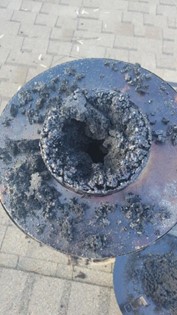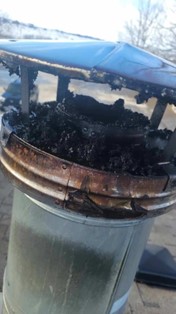Chimney & Fireplace Safety
- Jon Riley

- Feb 5, 2024
- 4 min read
Updated: May 24, 2024
As temperatures fall and you spend more time indoors in front of the fireplace, the last thing you want to think about is the condition of your chimney. Dirty chimneys can cause chimney fires, which damage or destroy homes and injure people.
Clean chimneys don’t catch fire. Make sure a professional chimney sweep inspects your solid fuel venting system annually and sweeps and repairs it whenever needed. Your sweep may have specific maintenance recommendations depending on how you use your fireplace or stove.
Before lighting a fire, make sure it is safe to do so. Be fire smart. Home fires occur more often in winter than in any other season.
The chimney and the flue that lines it are there to carry dangerous gases from the fireplace or wood stove safely out of the home.
What do chimneys do?
Fireplaces and wood stoves are designed to contain wood-fuel fires while providing heat for a home. Chimneys expel the by-products of combustion that include smoke, water vapor, gases, unburned wood particles, hydrocarbon, tar fog and assorted minerals. As these substances leave the fireplace or wood stove, and flow up into the relatively cooler chimney, condensation occurs. The resulting residue that sticks to the inner walls of the chimney is called creosote.
What is creosote?
Creosote is a black or brown residue that can be crusty and flaky—tar-like, drippy and sticky—or shiny and hardened. All forms are highly combustible. If it builds up in sufficient quantities, and the internal flue temperature is high enough, the result could be a chimney fire.
Conditions that cause the buildup of creosote:
Restricted air supply and unseasoned wood encourage the buildup of creosote. To avoid that buildup:
Do not restrict the air supply:
By closing the glass doors.
By failing to open the damper wide enough. The longer the smoke is in the flue, the more likely is it that creosote will form.
By closing down the stove damper or air inlets on a wood stove too soon or too much.
Do not burn unseasoned wood:
So much energy is used initially just to drive off the water trapped in the cells of the logs that it keeps the resulting smoke cooler than if seasoned wood is used.
In the case of wood stoves, overloading the firebox with wood to get a longer burn time also contributes to creosote buildup.
Fireplace safety:
Keep a glass or metal screen in front of the fireplace to prevent embers or sparks jumping out.
Do not burn paper in your fireplace.
Put the fire out before you go to sleep or leave your home.
Put ashes in a metal container with a lid, outside, at least 3 feet from your home.
Wood stove safety:
Make sure your stove is 3 feet from anything that can burn.
Do not burn paper in your wood stove.
Put the fire out before you go to sleep or leave your home.
Best And Worst Types of Wood for Your Fireplace
In Washington, fall means chilly nights and warm fireplaces. You probably already know that, but do you know the best and worst types of wood for your fireplace? Why is that important? Because some wood burns better than others, and some wood is dangerous when burned. Let's take a closer look.
Best Types of Wood for Your Fireplace
Oak: Oak is a hardwood that generates a minute flame and a steady heat. It also burns for a long time. However, it needs to be cured for at least a year.
Hickory: Hickory is known to create high heat, and its signature hickory smell which makes it so popular for smoking meat; it's undoubtedly one of the best woods for burning.
Maple: Like oak, maple produces a steady flame with a constant heat output. Its subtly sweet smell puts one in mind of maple syrup.
Ash: Ash burns steadily and delivers a fair amount of heat, even when green. But like all woods, it's better once it has been cured.
Birch: Unlike oak, birch burns quickly but can give off heat that doesn't overwhelm. The bark of the birch also makes an excellent fire starter.
Cherry: While cherry wood gives off a pleasant fragrance when burned, it doesn't burn as hot as other wood.
Worst Types of Wood for Your Fireplace
Pine: The upside of pine is that it can burn hot and can be used for kindling. The downside is that it produces a lot of creosote, a highly flammable substance that can accumulate in your chimney's flue, raising the risk of a chimney fire.
Spruce: Spruce is similar to pine; it's pitchy and can lead to creosote build-up.
Poplar: This wood produces an awful smell when burned.
Green or Wet Wood: Any wood that has yet to be appropriately cured will produce excessive smoke and inadequate heat and can lead to creosote accumulation. Always burn dry wood in your fireplace.
Driftwood: It might seem tempting because of its abundance on our lake shores, but burning driftwood releases toxic chemicals due to its salt content and can harm your family and pets.
Treated or Painted Wood: Any wood that's been chemically treated or painted releases toxic fumes when burned, some of which will not only make your family and pets sick, but can be deadly as well. Never burn treated wood in your fireplace
Types of Wood That Generally Don't Burn Well in Your Fireplace
Willow: Willow doesn't burn hot and tends to produce exorbitant amounts of smoke.
Alder: This wood is just a lot of work for no results. Alder burns quickly and doesn't produce much heat.
Chestnut: Produces a lot of smoke and a weak flame.
Gum: Prone to producing sparks, which can become a fire hazard.
To Sum Up
In conclusion, the type of wood you choose can significantly impact the warmth, atmosphere, and safety of your fireplace. Remember to ensure the wood you burn in your fireplace is cured and avoid burning wood that's been treated with chemicals or painted. Regularly inspecting and cleaning your fireplace and chimney by a qualified chimney sweep service is an excellent way to prevent potential fire hazards.











